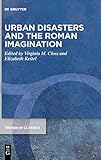Urban Disasters and the Roman Imagination / ed. by Virginia M. Closs, Elizabeth Keitel.
Material type: TextSeries: Trends in Classics - Supplementary Volumes ; 104Publisher: Berlin ; Boston : De Gruyter, [2020]Copyright date: ©2020Description: 1 online resource (XI, 286 p.)Content type:
TextSeries: Trends in Classics - Supplementary Volumes ; 104Publisher: Berlin ; Boston : De Gruyter, [2020]Copyright date: ©2020Description: 1 online resource (XI, 286 p.)Content type: - 9783110674699
- 9783110674767
- 9783110674736
- DG78 .U73 2020
- online - DeGruyter
- Issued also in print.
| Item type | Current library | Call number | URL | Status | Notes | Barcode | |
|---|---|---|---|---|---|---|---|
 eBook
eBook
|
Biblioteca "Angelicum" Pont. Univ. S.Tommaso d'Aquino Nuvola online | online - DeGruyter (Browse shelf(Opens below)) | Online access | Not for loan (Accesso limitato) | Accesso per gli utenti autorizzati / Access for authorized users | (dgr)9783110674736 |
Frontmatter -- Contents -- Acknowledgments -- List of Figures -- Abbreviations -- Introduction -- Part I: Literary Elaborations of the Urbs Capta Motif -- Urban Disasters and Other Romes -- “One city captures us” -- Pliny’s Telemacheia -- Part II: The Causes of Urban Disasters -- Rome’s Sicilian Disaster -- Winning Too Well -- Urbs/Orbis -- Horace on Moral Clades in Odes 3.6 and the Carmen saeculare -- Part III: Commemoration of Disasters -- The Unmaking of Rome -- Josephus’ Memory of Jerusalem -- The Sacks of Rome, 390 BCE–2017 CE -- Bibliography -- List of Contributors -- Index Locorum -- General Index
restricted access online access with authorization star
http://purl.org/coar/access_right/c_16ec
This book affords new perspectives on urban disasters in the ancient Roman context, attending not just to the material and historical realities of such events, but also to the imaginary and literary possibilities offered by urban disaster as a figure of thought. Existential threats to the ancient city took many forms, including military invasions, natural disasters, public health crises, and gradual systemic collapses brought on by political or economic factors. In Roman cities, the memory of such events left lasting imprints on the city in psychological as well as in material terms. Individual chapters explore historical disasters and their commemoration, but others also consider of the effect of anticipated and imagined catastrophes. They analyze the destruction of cities both as a threat to be forestalled, and as a potentially regenerative agent of change, and the ways in which destroyed cities are revisited — and in a sense, rebuilt— in literary and social memory. The contributors to this volume seek to explore the Roman conception of disaster in terms that are not exclusively literary or historical. Instead, they explore the connections between and among various elements in the assemblage of experiences, texts, and traditions touching upon the theme of urban disasters in the Roman world.
Issued also in print.
Mode of access: Internet via World Wide Web.
In English.
Description based on online resource; title from PDF title page (publisher's Web site, viewed 28. Feb 2023)


